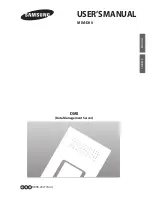
108
D14049.07
March 2010
Grey Headline
(continued)
TANDBERG
VIDEO COMMUNICATION SERVER
ADMINISTRATOR GUIDE
Introduction
Overview and
status
System
configuration
VCS
configuration
Zones and
neighbors
Clustering and
peers
Call
processing
Bandwidth
control
Firewall
traversal
Appendices
Applications
Maintenance
URI dialing
Types of DNS records required
The ability of the VCS to receive incoming calls made using URI dialing via DNS relies on the
presence of DNS records for each domain the VCS is hosting.
These records can be of various types including:
•
A records
, which provide the IPv4 address of the VCS
•
AAAA records
, which provide the IPv6 address of the VCS
•
Service (SRV) records
, which specify the FQDN of the VCS and the port on it to be queried for a
particular protocol and transport type.
•
NAPTR records
, which specify SRV record and transport preferences for a SIP domain.
You should provide an SRV or NAPTR record for each combination of domain hosted and protocol
and transport type enabled on the VCS.
Incoming call process
When an incoming call has been placed using URI dialing via DNS, the VCS will have been located
by the calling system using one of the DNS record lookups described above. The VCS will receive
the request containing the dialed URI in the form
. This will appear as coming
from the Default Zone. The VCS will then search for the URI in accordance with its normal
search
process
, applying any pre-search transforms, Call Policy and FindMe policy, then searching its Local
Zone and other configured zones, in order of search rule priority.
SRV record format
The format of SRV records is defined by
RFC 2782 [3]
as:
_ Service. _ Proto.Name TTL Class SRV Priority Weight Port Target
For the VCS, these will be as follows:
•
_ Service
and
_ Proto
will be different for H.323 and SIP, and will depend on the protocol
and transport type being used.
•
Name
is the domain in the URI that the VCS is hosting (e.g. example.com)
•
Port
is the IP port on the VCS that has been configured to listen for that particular service and
protocol combination
•
Target
is the FQDN of the VCS.
Configuring H.323 SRV records
Annex O of
H.323 [15]
defines the procedures for using DNS to locate gatekeepers and endpoints
and for resolving H.323 URL aliases. It also defines parameters for use with the H.323 URL.
The VCS supports two types of SRV record as defined by this Annex. These are Location and Call,
with
_ Service
set to
_ h323ls
and
_ h323cs
respectively.
If you wish the VCS to be contactable using H.323 URI dialing, you should provide at least a
Location SRV record, as it provides the most flexibility and the simplest configuration.
Location SRV records
For each domain hosted by the VCS, you should configure a Location SRV record as follows:
•
_ Service
is
_ h323ls
•
_ Proto
is
_ udp
•
Port
is the port number that has been configured from
VCS configuration > Protocols > H.323
as the
Registration UDP port
.
Call SRV records
Call SRV records (and A/AAAA records) are intended primarily for use by endpoints which cannot
participate in a location transaction, exchanging LRQ and LCF. The configuration of a Call SRV record
should be as follows:
•
_ Service
is
_ h323cs
•
_ Proto
is
_ tcp
•
Port
is the port number that has been configured from
VCS configuration > Protocols > H.323
as the
Call signaling TCP port
.
Configuring SIP SRV records
RFC 3263 [16]
describes the DNS procedures used to resolve a SIP URI into the IP address, port,
and transport protocol of the next hop to contact.
If you wish the VCS to be contactable using SIP URI dialing, you should configure an SRV record for
each SIP transport protocol enabled on the VCS (i.e. UDP, TCP or TLS) as follows:
•
Valid combinations of
_ Service
and
_ Proto
are:
•
_ sips. _ tcp
•
_ sip. _ tcp
•
_ sip. _ udp
•
Port
is the IP port number that has been configured from
VCS configuration > Protocols > SIP
as the
port
for that particular transport protocol.
URI dialing via DNS for incoming calls
















































